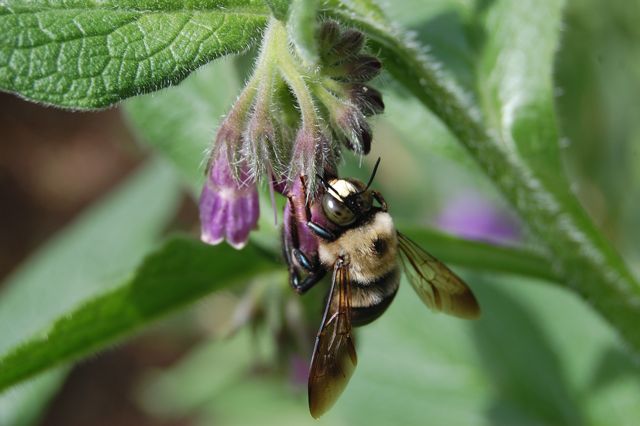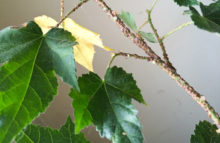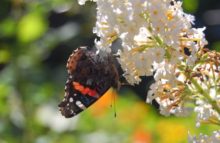After yesterday’s heartless post on the subject of aphids and leafrollers, it’s incumbent of me [oops, I mean: on me] to say: not all bugs are bad bugs. Not even bugs with bad-boy reputations.
Even in this day of catastrophic bee decline, Google carpenter bees, for example, and 99% of the results will be about how to do away with them. People tend to equate them with termites. They’re not even close.
We have willingly shared our garden – or, more to the point, our cedar garden shed – with many generations of Eastern carpenter bees (Xylocopa virginica). They are excellent pollinators, are not aggressive and are fascinating to watch; more of a curiosity than a pest.
Male carpenter bee emerging from the hibernaculum: Hey, our carpentry work isn’t usually this messy.
The males (identified by the white patch on their face) will check you o
ut, as males are wont to do, but have no sting. The females do have a stinger, but rarely use it. They’re too busy collecting food.
 Their name derives from their practice of drilling a tunnel in wood in order to lay their eggs and hiberate. They don’t eat the wood – one of the first signs they’re active here in spring is the wood frass or sawdust on the comfrey below. Nor do they create large colonies, as honeybees and other social bees do.
Their name derives from their practice of drilling a tunnel in wood in order to lay their eggs and hiberate. They don’t eat the wood – one of the first signs they’re active here in spring is the wood frass or sawdust on the comfrey below. Nor do they create large colonies, as honeybees and other social bees do.
Each female lives about a year, and the daughters hibernate over winter and return to the burrow or hibernaculum from which they hatched to lay their eggs, or they create a new burrow nearby. Wood damage is generally superficial, less due to the bees than to the woodpeckers drilling to find bee larvae.
They love my shed, making their home in the same board for many years and leaving my home alone. You could say that they’re me-leavers.
A carpenter bee can be distinguished from the similarly sized bumblebee by the abdomen: the carpenter’s is shiny black, not furry. Its thorax or midsection is covered with yellow hairs, and carpenters have a black spot, like a monk’s tonsure, in the centre.
As I said, they’re active pollinators, and for this reason alone we should think twice about blindly doing away with them. As they’re big bees with the right equipment, they do sometimes cheat, as I watched the female above do yesterday
. She drilled through the tops of the columbine spurs to get at the nectar, without brushing by the stamens and pistil to
pollinate the flower. Tsk.
Well, that’s okay guys. You can stay. Until further notice, I’ll remain a bee-leaver.
The white patch on its face tells you that this is a male carpenter bee. Th
online pharmacy buy lasix with best prices today in the USAat, and the glint in his eye.







13 comments
Interesting write up on carpenter bees.
~ bangchik
Those are fantastic photos! I'll be honest – I'm glad we don't have carpenter bees where I live. I love to watch our bumblers and I'm much less annoyed by the mason bees taking up residence in the weep holes in our windows. Granted… we can't open our windows without letting them in the house though. We plan to build mason bees houses in hopes that they'll leave our weep holes alone.
I'm glad you were able to get such good photos of the bee. I wanted to photograph the bee on the purple columbine in our backyard but when I came back the the garden the bee had already moved on. It looked to me like the bee was biting into the spurs to get the nectar rather than entering the flower the usual way (which probably wouldn't have worked).
I guess aphids aren't really "bad" bugs either. To a ladybug.
Apparently Seeds of Diversity has a bee watch program. We must check it out.
Glad I know what a carpenter bee looks like now. I'll always think of their "Black Bottom". Wasn't that a dance in the 1920s?
They are eating my porch. I have to go behind them and fill the holes. So far they aren't driving me nuts and I do leave them alone.
Enjoyed the post and pictures
I think we have one of everything bugwise. I enjoyed your blog post. Happy gardening all week.
Hi, flowergardengirl — The bees in my garden reused the same hole year after year until predators opened it up from the side and they had to create a new one. So, perhaps you could leave them one hole and see what happens.
In orchards, where carpenter bees are very useful pollinators, I've read that farmers put an attractive (in bee terms) block of wood for the bees to use.
Here, they use the shed, which is old and unpainted, and leave the wood on my house alone. Maybe a nice, chewy chunk of cedar would offer them a bee house that's more alluring to nest in than your porch?
good stuff!
Ohhh–one of those guys moved into the railing on my balcony last summer and left lovely cone-shaped heaps of sawdust in the pansies while he dug his little home. The only issue was territory–the bee would dive-bomb my head while I lounged, which didn't make for a whole lot of relaxing.
The dive-bombing is benign. It's likely the "he" of the equation, and he has no stinger. In fact, he likely thinks you're a girl bee and is checking just in case.
So, no black and yellow striped tops, or he'll think you're engaged.
Hi Helen, sorry so tardy in coming to read up on these friends of the garden. I now have ammunition against The Financier, who thinks they should be abolished for making holes in our deck, fench, shed and eaves. There seems no way to stop them though, without resorting to banned substances in the Fairegarden. We have found them to be more slow moving than the other bees, easier to photograph. 🙂
Frances
Great post, and there's another reason to love them – they are territorial enough to keep German yellow jackets from starting nests in your yard. They may do a bit of damage to our shed, but we have very few wasp issues. I just wish they were still on the wing in early fall!
i have quite a few living in the upper (6×6) beem of my deck in North Toronto, i have two young children (2 & 4) and have never been concerned about the bees becoming aggressive. just keep a hand over your summer cocktail unless you want want wood fiber in your diet, plenty of falling sawdust in May and June.